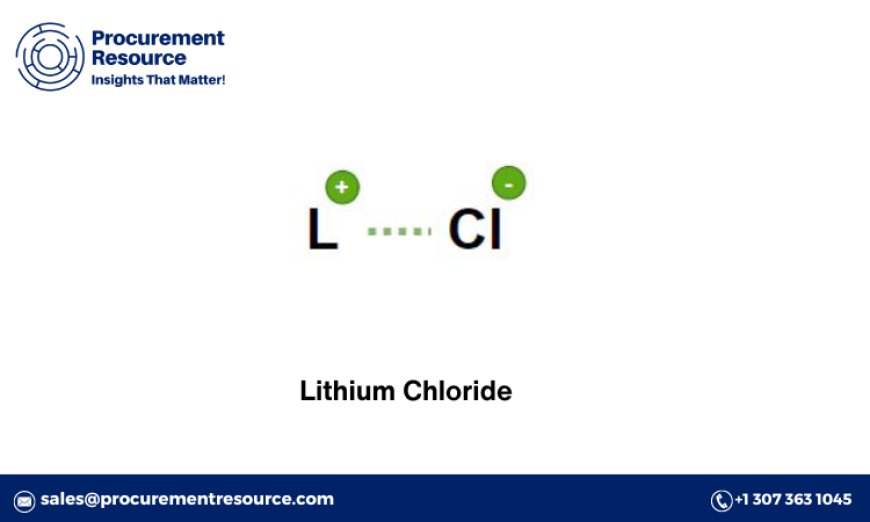The Ultimate Guide to Lithium Chloride Production Process
Lithium chloride (LiCl) is an inorganic compound known for its exceptional solubility in water and its hygroscopic properties.

Lithium chloride (LiCl) is an inorganic compound known for its exceptional solubility in water and its hygroscopic properties. It is commonly used in various applications such as air conditioning, industrial drying systems, and in the manufacture of lithium metal. As the demand for lithium-ion batteries continues to surge due to the growth in electric vehicles and renewable energy storage, the production and cost analysis of lithium chloride has gained significant attention. This blog delves into the intricacies of the lithium chloride production process, the associated costs, and the latest trends and news in the industry.
Lithium Chloride Production Cost
Understanding the cost structure of lithium chloride production is crucial for manufacturers and investors. The production cost of lithium chloride is influenced by various factors, including raw material prices, energy consumption, labor costs, and the efficiency of the manufacturing process.
-
Raw Materials: The primary raw materials for lithium chloride production are lithium carbonate or lithium hydroxide, and hydrochloric acid. The cost of these raw materials can fluctuate based on market demand, availability, and geopolitical factors.
-
Energy Consumption: The production process requires significant energy, particularly for heating and evaporation stages. Energy costs can vary depending on the location of the manufacturing plant and the source of energy used.
-
Labor Costs: Labor expenses include wages, benefits, and training costs for the workforce involved in the production process. These costs can vary significantly depending on the country and region where the production takes place.
-
Manufacturing Efficiency: The efficiency of the production process, including the technology and equipment used, plays a critical role in determining the overall cost. Advanced technologies and optimized processes can reduce waste and improve yield, thereby lowering costs.
-
Transportation and Logistics: The cost of transporting raw materials to the manufacturing plant and the final product to the market also contributes to the overall production cost.
Request For Sample: https://www.procurementresource.com/production-cost-report-store/lithium-chloride/request-sample
Manufacturing Process
The production of lithium chloride involves several steps, each requiring specific conditions and technologies. Below is an overview of the standard manufacturing process:
-
Preparation of Lithium Carbonate: Lithium carbonate is typically derived from lithium-containing minerals such as spodumene or from lithium-rich brines. The mineral is crushed and heated to extract lithium carbonate.
-
Reaction with Hydrochloric Acid: Lithium carbonate or lithium hydroxide is then reacted with hydrochloric acid (HCl) to produce lithium chloride. The reaction can be represented as:
-
Purification: The lithium chloride solution obtained from the reaction contains impurities that must be removed. This is typically done through filtration and chemical precipitation methods.
-
Evaporation and Crystallization: The purified lithium chloride solution is concentrated by evaporation to increase the lithium chloride content. The concentrated solution is then cooled to precipitate lithium chloride crystals.
-
Drying and Packaging: The lithium chloride crystals are dried to remove any remaining moisture and then packaged for distribution.
Manufacturing Report
A comprehensive manufacturing report for lithium chloride production includes detailed information on the production process, equipment used, raw material sourcing, and cost analysis. The report typically covers the following aspects:
-
Process Flow Diagram: A visual representation of the entire production process, highlighting each stage and the flow of materials.
-
Equipment and Technology: Details on the machinery and technology employed in the production process, including specifications and operational parameters.
-
Raw Material Sourcing: Information on the suppliers of raw materials, quality standards, and logistics.
-
Cost Analysis: A breakdown of the production costs, including raw material costs, energy consumption, labor, and other overheads.
-
Environmental and Safety Compliance: Compliance with environmental regulations and safety standards, including waste management and emission control measures.
Raw Material Costs
The cost of raw materials is a significant component of the overall production cost of lithium chloride. The primary raw materials are lithium carbonate or lithium hydroxide and hydrochloric acid.
-
Lithium Carbonate/Lithium Hydroxide: The price of lithium carbonate or lithium hydroxide is influenced by the availability of lithium resources, extraction costs, and market demand. Lithium prices have been volatile in recent years due to the increasing demand for lithium-ion batteries.
-
Hydrochloric Acid: The cost of hydrochloric acid is relatively stable compared to lithium compounds, but it can still vary based on production capacity and transportation costs.
-
Market Trends: The prices of these raw materials are also affected by global market trends, trade policies, and supply chain disruptions.
Latest News
Staying updated with the latest news and developments in the lithium chloride market is essential for industry stakeholders. Here are some recent trends and news:
-
Rising Demand for Lithium-Ion Batteries: The growing adoption of electric vehicles and renewable energy storage solutions has led to an increased demand for lithium chloride, a key component in lithium-ion batteries.
-
Technological Advancements: Innovations in extraction and production technologies are improving the efficiency and sustainability of lithium chloride production. Companies are investing in research and development to optimize processes and reduce costs.
-
Environmental Regulations: Stricter environmental regulations are driving the adoption of cleaner production methods and the development of recycling technologies for lithium compounds.
-
Market Expansion: New production facilities are being established in regions with abundant lithium resources, such as Australia and South America, to meet the rising global demand.
-
Supply Chain Challenges: The lithium market has experienced supply chain disruptions due to geopolitical tensions, trade restrictions, and the COVID-19 pandemic. These challenges have impacted the availability and prices of raw materials.
Conclusion
The production of lithium chloride is a complex process influenced by various factors, including raw material costs, energy consumption, and manufacturing efficiency. Understanding the cost structure and staying informed about the latest industry trends are crucial for manufacturers and investors. As the demand for lithium-ion batteries continues to grow, advancements in production technologies and sustainable practices will play a vital role in shaping the future of the lithium chloride market.
